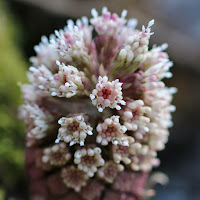Nederlands: Groot hoefblad
Español:
Français: Grand pétasite - Étasite hybride - Chapelière - Grand pas d'âne
Deutsch: Gewöhnliche Pestwurz - Rote Pestwurz
Family: Asteracea - Daisy family
Flowering time: March-May
Height: 15-45 cm
Altitude: to 1800m
Colour: reddish-violet, pale pink
Leaves: rounded-heart-shaped, grey-hairy beneath, appearing after the flowers
Habitat: shady places beside waterways, in wet meadows, marshes, flood plains and damp roadsides
Distribution: northern and central Europe, naturalized in Scandinavia
Synonym: Petasites officinalis




Notes: Almost all parts of Petasites hybridus are bright red to maroon at first. A flowering spike emerges from the centre of a sheath of bracts with small leaves on the ends. Butterbur often forms large colonies. It is pollinated by insects and in early spring it is one of the first plants to provide nectar and pollen (only male plants provide white pollen). The flowers are either male or female, but only one sex is to be found in one area. Female plants have flower clusters that are smaller and they hardly open, but the flowers spikes are longer than those belonging to male plants. The mature leaves of Butterbur reach up to one metre across. The leaves were at one time used for wrapping butter hence the common English name. In Belgium Petasites hybridus is on the Red List of vascular plants.
Related key words: Rotterdam, Kralingse Bos, insect
